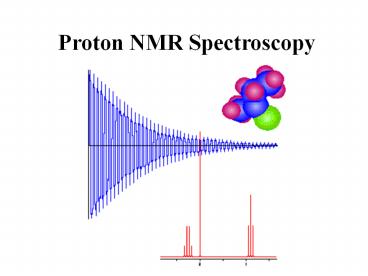Proton NMR Spectroscopy - PowerPoint PPT Presentation
Title:
Proton NMR Spectroscopy
Description:
Proton NMR Spectroscopy The NMR Phenomenon Most nuclei possess an intrinsic angular momentum, P. Any spinning charged particle generates a magnetic field. – PowerPoint PPT presentation
Number of Views:1218
Avg rating:3.0/5.0
Title: Proton NMR Spectroscopy
1
Proton NMR Spectroscopy
2
The NMR Phenomenon
- Most nuclei possess an intrinsic angular
momentum, P. - Any spinning charged particle generates a
magnetic field. - P I(I1)1/2 h/2p
- where I spin quantum
- I 0, 1/2, 1, 3/2, 2,
3
Which nuclei have a spin?
- If mass and atomic are both even, I 0 and
the nucleus has no spin. - e.g. Carbon-12, Oxygen-16
- For each nucleus with a spin, the of allowed
spin states can be quantized - For a nucleus with I, there are 2I 1 allowed
spin states. - 1H, 13C, 19F, 31P all have I 1/2
- DE g(h/2p)Bo
4
Spin states split in the presence of B0
5
- When a nucleus aligned with a magnetic field,
B0, absorbs radiation frequency (Rf), it can
change spin orientation to a higher energy spin
state. By relaxing back to the parallel (1/2)
spin state, the nucleus is said to be in
resonance. Hence, - NMR
6
Presence of Magnetic Field
7
NMR instruments typically have a constant Rf and
a variable B0. A proton should absorb Rf of 60
MHz in a field of 14,093 Gauss (1.4093 T). Each
unique probe nucleus (1H perhaps) will come into
resonance at a slightly different - and a very
small percentage of - the Rf. All protons come
into resonance between 0 and 12/1,000,000 (0 12
ppm) of the Rf.
8
Energy Difference (?E) Between Two Different Spin
States of a Nucleus With I1/2
9
What Does an NMR Spectrum Tell You?
- of chemically unique Hs in the molecule of
signals - The types of Hs that are present e.g. aromatic,
vinyl, aldehyde chemical shift - The number of each chemically unique H
integration - The Hs proximity to eachother spin-spin
splitting
10
How many signals in the Proton NMR Spectrum?
11
(No Transcript)
12
Chemical EquivalenceHow many signals in 1H NMR
spectrum?
13
Number of Equivalent Protons
14
Vinyl Protons
15
(No Transcript)
16
(No Transcript)
17
(No Transcript)
18
(No Transcript)
19
(No Transcript)
20
Typical 1H NMR Scale is 0-10 ppm
21
The d Scale
22
Tetramethylsilane (TMS)
23
Chemical Shift Ranges, ppm
24
(No Transcript)
25
Diamagnetic AnisotropyShielding and Deshielding
26
Deshielding in Alkenes
27
Shielding in Alkynes
28
Chemical Shift is Affected by Electron Density
Around Nucleus
29
(No Transcript)
30
from chemistry.msu.edu
31
(No Transcript)
32
Methyl t-butyl ether (MTBE)
33
Toluene at Higher Field
34
Integral TraceHow many protons give rise to each
signal?
35
Spin-Spin Splitting
36
The Doublet in 1H NMR
37
Hb in 1,1,2-Tribromoethane
38
The Triplet in 1H NMR
39
Ha in 1,1,2-Tribromoethane
40
1,1,2-Tribromoethane
41
The Quartet in 1HMR
42
Predict Splitting
43
1,1-Dichloroethane
44
Methyl Group appears as an Upfield Doublet
45
Methine H Appears as a Downfield Quartet
46
Ethyl benzene
47
Methyl Isopropyl Ketone
48
1-Nitropropane
49
2-Methyl-1-propanol
50
Para Nitrotoluene
51
(No Transcript)
52
(No Transcript)
53
C-13 NMR Spectroscopy
54
C-13 chemical shifts
55
(No Transcript)
56
Coupling in C-13 NMR
57
(No Transcript)
58
(No Transcript)
59
Butanone - Coupled and Decoupled
60
1,2,2-Trichloropropane1H and 13C NMR Spectra
61
Coupled C-13 NMR Spectrum
62
(No Transcript)
63
(No Transcript)
64
(No Transcript)
65
(No Transcript)
66
(No Transcript)































